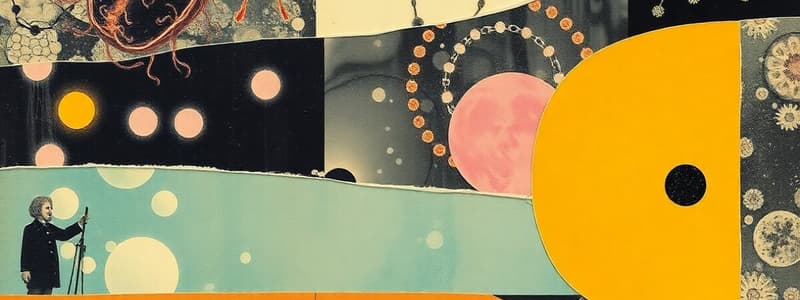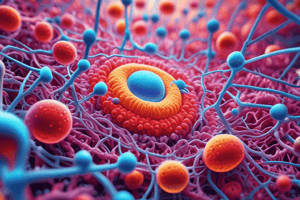Podcast
Questions and Answers
What is the significance of Koch's postulates in microbiology?
What is the significance of Koch's postulates in microbiology?
Which macromolecule is primarily made up of carbon, hydrogen, and oxygen and serves as a primary energy source for cells?
Which macromolecule is primarily made up of carbon, hydrogen, and oxygen and serves as a primary energy source for cells?
Which type of microscopy uses staining techniques to distinguish between different cellular structures?
Which type of microscopy uses staining techniques to distinguish between different cellular structures?
What is the role of enzymes in biological reactions?
What is the role of enzymes in biological reactions?
Signup and view all the answers
What type of staining is used to visualize endospores in bacterial cells?
What type of staining is used to visualize endospores in bacterial cells?
Signup and view all the answers
Flashcards
Koch’s postulates
Koch’s postulates
A series of criteria to establish a causative relationship between a microbe and a disease.
Macromolecules
Macromolecules
Large molecules essential for life, including proteins, nucleic acids, lipids, and carbohydrates.
Gram-stain
Gram-stain
A laboratory technique that classifies bacteria into two groups based on cell wall composition.
Competitive inhibition
Competitive inhibition
Signup and view all the flashcards
Photosynthesis types
Photosynthesis types
Signup and view all the flashcards
Study Notes
Unit 1 Review: Chapters 1-5
- Chapter 1: Focuses on microbiology history, categorizing microbes (bacteria, archaea, protozoa, fungi) and their roles. Includes key figures, microbial definitions (mycology, bacteriology), bioremediation, infectious diseases, and biofilms.
Chapter 2
- Atoms and Molecules: Discusses atomic structures, bonding types (covalent, polar, nonpolar, and noncovalent), acids/bases (pH), and the significance of carbon.
- Macromolecules: Covers the structure, function, and monomers of macromolecules.
Chapter 3
- Microscopy: Explores light microscopy, its parts, functions, and different types like simple vs. differential staining.
- Staining Techniques: Focuses on gram-staining, acid-fast stain, negative, endospore, and flagella staining techniques.
Chapter 4
- Prokaryotic Cell Structure: Details bacterial shapes, arrangements, and external structures.
- Cellular Components: Emphasizes cell wall structures, plasma membranes, their properties, transportation mechanisms, inclusions, and endospores (with regards to bacteria).
- Eukaryotic Cells: Briefly touches upon eukaryotic cell organelles.
Chapter 5
- Enzymes and Their Inhibition: Covers enzyme inhibition (competitive, allosteric, feedback).
- ATP Production: Defines 3 ways cells make ATP (e.g. respiration).
- Respiration, Fermentation, and Biochemical Tests: Explores the metabolic processes of respiration (in detail) and its steps for energy production, fermentation alternatives, as well as biochemical tests.
- Photosynthesis: Explores photosynthesis, its stages (light and dark reactions), and the Calvin cycle.
- Types of Metabolic Feeding: Discusses different types of metabolic feeding (photoautotrophs, chemoheterotrophs, etc.).
Studying That Suits You
Use AI to generate personalized quizzes and flashcards to suit your learning preferences.
Related Documents
Description
This quiz reviews key concepts from the first unit of microbiology, covering chapters 1 to 5. Topics include the history and categorization of microbes, atomic structures and macromolecules, microscopy techniques, and the structure of prokaryotic cells. Test your understanding of these essential foundational concepts in microbiology.




